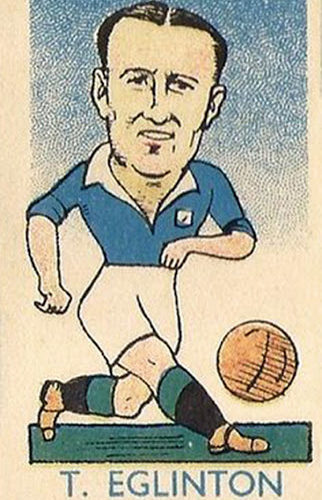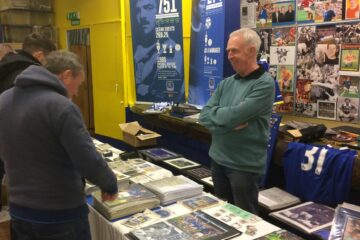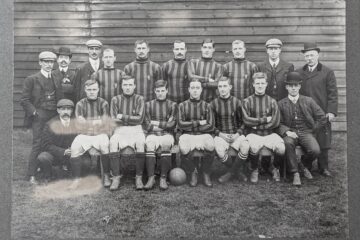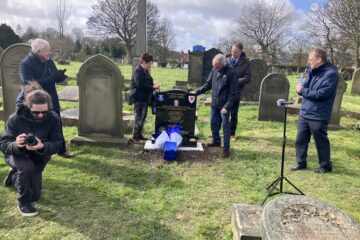Tommy Eglington, the Irish international left-winger, gave unstinting service to the Blues’ cause during some of the club’s darkest days. He is forever associated with his teammate and great friend, Peter Farrell, who crossed the Irish Sea with him in 1946.
Tommy was born in Donnycarney, a Northside suburb of Dublin on 15th January 1923. He was one of seven siblings born to Christopher (a butcher by trade) and Margaret. As was the norm, Gaelic Football was played in school, so Tommy would only get to indulge his passion for the ‘British game’ in the fields near his home after lessons finished. His early footballing experience was with Grace Park – a Sunday team he formed with friends (it disbanded when the war broke out). On a Grave Park tour of the Midlands he was offered a trial with West Bromwich Albion but he turned it down – feeling that he was too young to leave home. He’d go on to play for Munster Victoria and Dublin Distillery before being picked up by Shamrock Rovers in 1943, and it was there that the left winger appeared in three successive FAI Cup Finals. Away from football Tommy worked in the family butchery firm (his brothers would also enter the trade).
As the Second World Draw to a close, Everton FC was on the lookout for fresh blood (at modest prices, in those austere times) to supplement the aging and depleted squad. Secretary-Manager Theo Kelly and Chairman Ernest Green watched Shamrock Rovers play Glentoran in Belfast, scouting a particular player. But it was the performances of Tommy and Peter Farrell that caught their attention. After the match the Toffees officials approached the pair and the railway station and asked for the contact details for the Shamrock Rovers Chairman. Tommy and Peter obliged, doubting that anything would come of it. Rovers were chaired and supported financially by a successful bookmaker Joe Cunningham but it was his wife, May who was hands on in the operation of the club and team selection. So, a short while later, Kelly headed to Dublin to negotiate a double-transfer – mindful that other English clubs were displaying interest. The £3,000 deal – £2,000 for Farrell and £1,000 for Tommy (although reported in the press as £10,000) – was agreed between the clubs but the two players took some time to consider whether they wanted to leave home and go to England, which was in slow recovery from the ravages of war. In the end the lure of playing in the Football League for a big club with a huge fanbase won out over concerns over rationing etc. The transfer was finalised on the evening of 11th July. May Cunningham told the Liverpool-based sports journalist Don Kendall (‘Pilot’): “You will find Peter and Tommy charming fellows and grand players.’
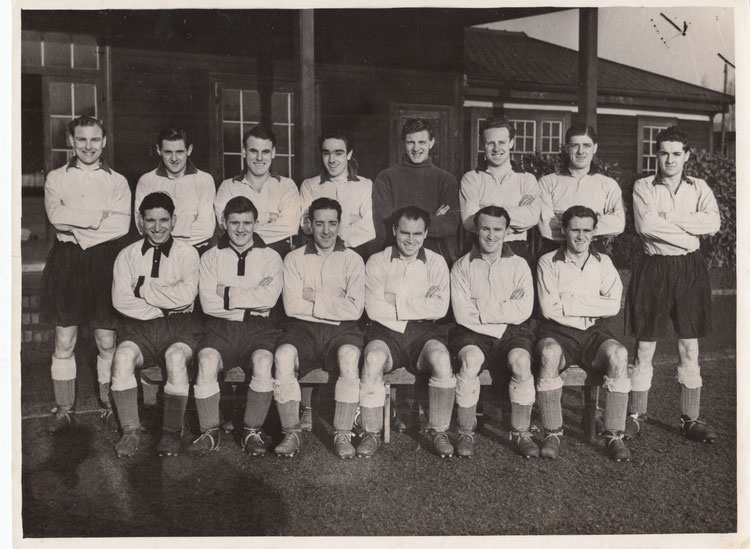
The Everton team in change shirts in the late 1940s
On 29th August 1946, nearly three weeks after Everton’s pre-season preparations got underway, Tommy and Peter set sail on the night ferry to Liverpool. It was a rough crossing and that, combined with the homesickness already creeping over him, made him contemplate staying on the boat for the return journey to Dublin. Such thoughts were dispelled by the smiling presence on the quay of Theo Kelly and Everton club captain Norman Greenhalgh. Their warm handshakes and greetings helped dispel the gloom and soon Tommy looked forward to playing for what he later described as ‘the greatest club in the world’. After a visit to a cafe next to Goodison Park and a quick tour of the ground, the pair were shown to their digs with Mrs Egan on Harris Drive in Bootle. The kind-hearted landlady became like a second mother to the pair and helped them settle on Merseyside. Tommy recalled a decade later: ‘We never felt a moment’s strangeness or anxiety. Right from the start we were made to feel as though we “belonged” and that we were one of the family. I shall never forget the happy days I spent in Harris Drive.’
Within a couple of days of disembarking in Liverpool, Tommy was having a brilliant debut for the reserves in a Central League fixture at Hillsborough. He progressed to the first team at Goodison on 11th September – he replaced Wally Boyes in the number eleven shirt for the visit of Arsenal. The result was a morale-boosting 3-2 victory. Stork wrote in the Daily Post that Tommy had ‘a successful debut without pulling up trees’ One pleasing aspect was the quick understanding established on the left of attack with compatriot Alex Stevenson. One match report noted: ‘Changes had to be made and these undoubtedly were all to the good. Don’t think that all is well, but there was definitely more combination in the side. Stevenson’s return to link up with the new Irish laddie, Eglington was a happy stroke, for Wee Alec…holds the ball, he slips it out to the open spaces and if his colleagues sense what he is about they move into those spaces.‘
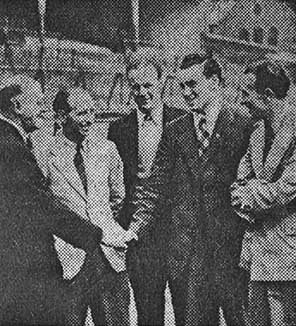
Tommy and Peter are welcomed to Goodison Park by Theo Kelly, Alex Stevenson and Norman Greenhalgh
Tommy was joined in the team two months later by Peter Farrell, once recovered from injury, who would go on to replace the departing Joe Mercer at wing-half. The pair became mainstays of the team for over a decade. Tommy got off the mark in his sixth appearance for the Blues. It was very welcome as the Toffees had not scored in the previous 298 minutes of play – an indication of the struggles being experienced. However, the goal came in a 4-1 pummelling at Roker Park. Shortly after returning to Merseyside from the match he wrote to update his parents on life at Everton: The letter is reproduced here:
Bootle, Liverpool
15/10/46
Dear Ma & Pa,
Just a few lines to let you know that I arrived back after my long journey. We left Liverpool at 5PM on Friday and we arrived in Newcastle at 10:30pm – we stayed there all the time – it was only a few miles from Sunderland. I slept with a Catholic – McIlhatton, the outside-right and the two of us went to Mass. We left Newcastle at 9:40 Sunday morning and arrived back in Liverpool at 4pm. It was a grand trip and they can take a beating very well, the directors included. Well pop, we were beaten badly – the team did not play as well as usual. I had a good game myself and scored a grand goal. Our outside-right sent in high ball and the opposing centre-half headed it away. Before it hit the ground I smacked it into the net. It was the best goal that I ever scored and all the lads gave me a great handshake after the match. They are the best fellas in the world and I don’t think there is a better club in England even though we are not doing too good. Sunderland have a great side and I would say that they are the best we have played so far.
Mum – I hope that you got the money I sent you. Have you made up your mind when you are coming over? I hope that it will be soon. Tell all the family I was asking for them…
Yours truly,
Tom
PS By the time you receive this letter we might be out on strike. If we do come out, Peter and I are going home.
Tommy was already a full international player when he joined Everton. His first call-up to the Dublin-based FAI side came in a match against Portugal in June 1946. Five months later he’d make the first of six appearances for the Belfast-based IFA – lining up with Peter Farrell, Alex Stevenson and Johnny Carey in a goalless draw with England. From 1948 onwards his appearances would solely be for the FAI – his 24th and last being in fixture with Spain in November 1955. In that era clubs were not obligated to release their players for international fixtures but Tommy would recall that Everton respected his patriotic desires:
‘They always treated me fairly when international honours came my way. There was never any moaning about the loss of services for a club game. It is things such as these which give players a feeling for a club.’ One of Tommy’s biggest regrets in his long football career was not being selected for the Irish side to face England at Goodison Park on 21st September 1949 (Tommy O’Connor of Shamrock Rovers got the nod to play). Blues teammates Peter Farrell and Peter Corr were chosen for the eleven captained by Johnny Carey. Tommy was would from the stand as Ireland inflicted the first defeat by a non-British team on English soil; Peter Farrell scored at the Park End in an Irish 2-0 win.
Tommy led a healthy lifestyle and was a dedicated trainer, determined to make the most of natural assets and continually improve. With that and the luck of avoiding serious injury (maybe defenders could not get near enough to clobber him) it’s little wonder that he enjoyed a long career. He won friends on the terraces for his direct, barnstorming wing play. Unlike predecessors like Jackie Coulter and Wally Boyes who indulged in trickery with the ball at their feet, he used his blistering pace to leave right-backs trailing in his wake. He was affectionately known as ‘Flash Eggo’ in recognition of his jet-heeled properties and Everton trainer Gordon Watson recalled:
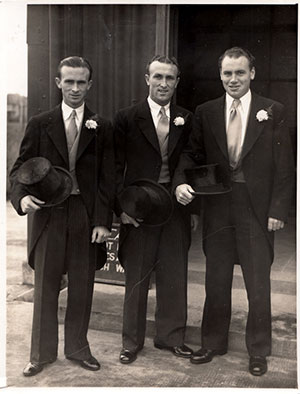
Tommy’s wedding day in 1950 with Peter Farrell as his Best Man
‘Tommy had the fastest feet in the game and Theo Kelly often joked that he’d received a complaint from fans in The Paddock about the smell of scorched turf’ Mick Meagan, who joined the club six years after his countryman, recalls: ‘When an Aer Lingus plane flew over Goodison we’d say ‘There’s Eggo flying up the wing!’ Tommy was very much left-footed and, in addition to crossing for the centre-forward, would often let-fly at goal (he scored 82 goals). His, more erratic, right-foot shots were a source of mirth for some supporters, but his ‘swinger’ improved over time.
Back home in Ireland, Tommy married Doris ‘Dorrie’ O’Donohue in the summer of 1950 – no prizes for guessing that the best man was Peter Farrell. In time, they raised three children, Bernard, Anthony and Paula. On returning to Liverpool, the newlyweds lodged for several months with Tommy’s former landlady Mrs Egan in Bootle until moving into a club house on Mostyn Avenue in Old Roan.
It was Tommy’s misfortune that his best years were spent in the doldrums of the Second Division (normally with John Willie Parker playing just inside of him and Dave Hickson leading the line). His greatest feat in the royal blue shirt occurred in September 1952 when he scored five goals in a 7-1 rout of Doncaster Rovers (player-managed by his friend and Ireland captain Peter Docherty). His haul had journalists leafing through the record books to check for precedents (Dixie Dean and scored five on three occasions whilst Jack Southworth hit six past West Brom in 1893 – but they were both centre-forwards). Ranger, in the Liverpool Echo, wrote: ‘Eglington has written his name in football annals in a manner that dozens of outstanding wingers of former days never achieved.’ Tommy, looking back some years later, said: ‘I remember two headers the most vividly. Both crosses from the right wing and I met them at the far post and nodded them in.’ Smiling, he noted that he had not been too greedy as John Willie Parker also weighed in with two goals!
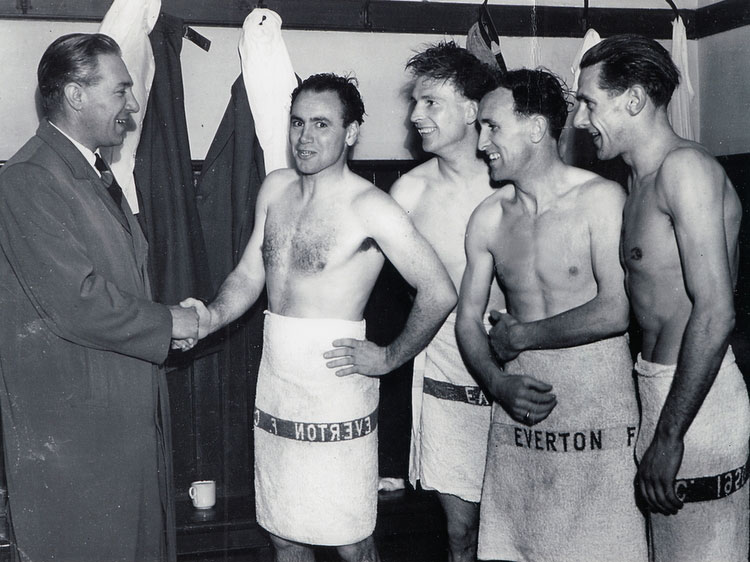
Congratulations are received from Cliff Britton on achieving promotion in 1954
Tommy missed only one match in the 1953/54 season as Everton earned promotion back to the top-flight in 1954. He rated this as a highlight of his career and recalled the journey to the final game of the season at Boundary Park: ‘Apart from the result, my outstanding memory was the support we had that night. We travelled along the East Lancs Road and it was packed with Everton supporters waving blue and white favours and cheering us on. It was an amazing sight.’
The arrival of new coach, Ian Buchan, in 1956 marked a shift towards blooding younger players, so Tommy’s days were numbered. One of the emerging local players was Brian Harris who later told the Everton match day programme: ‘When I got into the first team I was well looked-after by Eggo and all these players. When you are a young player that helps you a hell of a lot because they know how things work, They passed everything they learnt to me. Eggo was a good player, very quick. I can’t say enough about him. He was a smashing guy and we had a lot of laughs, and he’d always help you if you had any problems.’
Graham Williams took Tommy’s place on the left wing towards the end of the 1956/57 season. His final League appearance came in a home defeat to Portsmouth on 23rd March but he bowed out in fitting fashion in May when Everton played Shamrock Rovers in Dublin (for the record, Rovers won 4-2). In late June of that year the Merseyside press picked up on efforts being made by Third Division Tranmere to acquire the 34 year-old’s services – a £1,750 deal was swiftly finalised. Ranger, writing in the Liverpool Echo, lamented Tommy’s departure from L4 whilst recognising that time waits for no man:
We shall miss Eglington at Goodison Park –and possibly in more ways than one. I had hoped the same clemency might be extended to Eglington, bearing in mind his eleven years of whole-hearted service to the club and the fact that never once had he caused them a moment’s anxiety. Fortunately he has got fixed up all right. Eglington might not always have been everyone’s idea of a first-class winger. He had spells when he suffered off periods. But so does every player. Taken by and large over the eleven years, however, he gave Everton good value for his wages, and missed barely a couple of dozen matches. Football today is very strictly business – there is little or no room for sentiment. Nevertheless it is still a matter for regret when time brings its inevitable changes and a noted player has to stop down into a lower sphere where the cheers of the smaller crowds make less sweet music than those to which he has so long been accustomed.
Tommy had amassed 428 appearances for the Blues (the 12th highest appearance-maker as at April 2020). Everton did not find a satisfactory long-term successor for the number eleven shirt until John Morrissey arrived in 1962 (Tommy Ring had dazzled on the wing in 1960 before suffering a badly broken leg).
Tommy was joined a few months later by Peter Farrell a few months later (Farrell was appointed as Rovers’ player-manager – and regularly joked that he was going to sack Tommy). He enjoyed four productive seasons on The Wirral – he was almost an ever-present and racked up 185 appearances in League and cups (in spite of a fractured fibula in April 1960 he was back fit for the 1960/61 season). On the 17th April he bowed out from competitive football in this land – as fate would have it, it was at Goodison Park in the Liverpool Senior Cup semi-final. Watching the 4-1 victory for the Toffees from the stands was Tommy’s ex-strike partner, Harry Catterick, who had been appointed as Everton manager earlier that day. As he brought down the curtain on his career in England he was granted a benefit match at Prenton Park on 1st May 1961 against an All-Star XI which included Bryan Douglas, Dennis Stevens, Alan A’Court, Jimmy Armfield, Billy Liddell and Tommy’s former Everton teammate, Matt Woods. He was also given a fitting farewell at a civic function hosted by the Mayor of Birkenhead.
Returning to the Emerald Isle he turned out for (the now defunct) Cork Hibernians. Even at this veteran age, he was selected on multiple occasions for League of Ireland representative sides. Having hung up his boots in 1963 he focussed on his butchers business in Clontarf (he had founded it whilst at Tranmere but left his brother, Kevin, to manage it in his absence). Needless to say, football fans – not just of an Evertonian persuasion – would seek him out at the shop and request autographs or have photos taken. In time his son Anthony would take on the most famous butchers and victuallers in Ireland. Naturally Tommy met up with Peter Farrell regularly up until Peter’s death in 1993 and the families remained close.
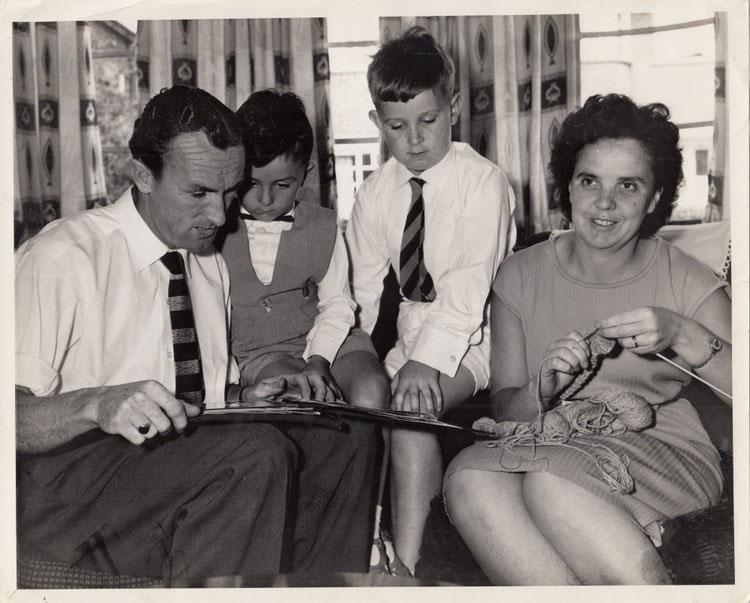
At home with the family
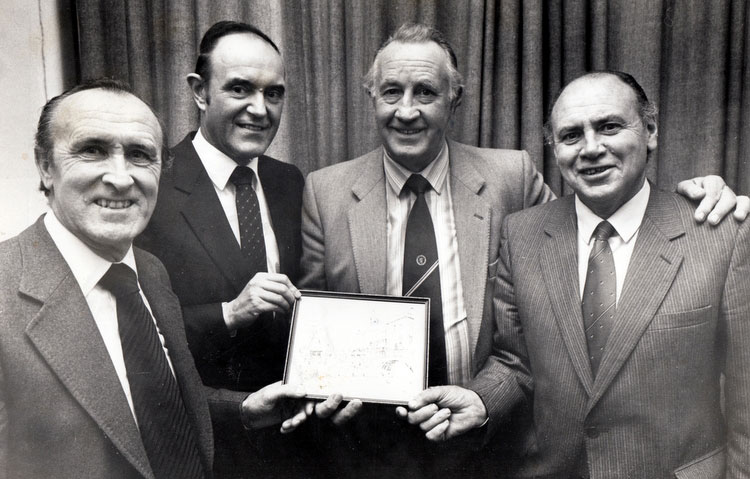
Tommy Eglington, Con Martin and Peter Farrell, circa 1980
A talented golfer, Tommy was a regular at St Anne’s club – being elected as captain in 1970. He’d got the links bug from Alec Stevenson in their time together at Everton. ‘Stevie’ took him to the course in Bootle for instruction (and no doubt some gentle leg-pulling). His first round took 117 strokes and cost him six lost, balls but soon the handicap was in single figures and he enjoyed a weekly fourball with Peter Farrell, Eddie Wainwright and Don Donovan.
Tommy remained an Evertonian – a copy of the Monday edition of the Liverpool Echo was posted to him every week by Terry Egan, the son of his former landlady in Bootle. He’d check the Everton reports first, followed by Tranmere and Liverpool (‘…because I have happy memories of them and their fans too’). He was a regular visitor to Merseyside to take in matches – his children being amazed when young supporters recognised him and asked for autographs. Such trips gave him the opportunity to visit Harry Leyland and his wife (who would in turn visit Dublin). He was at Everton’s Wembley Cup Finals in the mid-1980s and in 1995. Back home he’d watch the Toffees when they ventured over (for example, the European Cup Winners’ Cup match against UCD in 1984). He was also happy to oblige fans by attending supporters’ club functions in Dublin (with the Irish Toffees) and in Cork, where he’d sometimes go with friend and former teammate Don Donovan. He’d be interviewed about his playing career and once said: ‘I think that there was more enjoyment and fun in the days that Peter and I played. There’s so much money in the game now, and more pressure on players.’
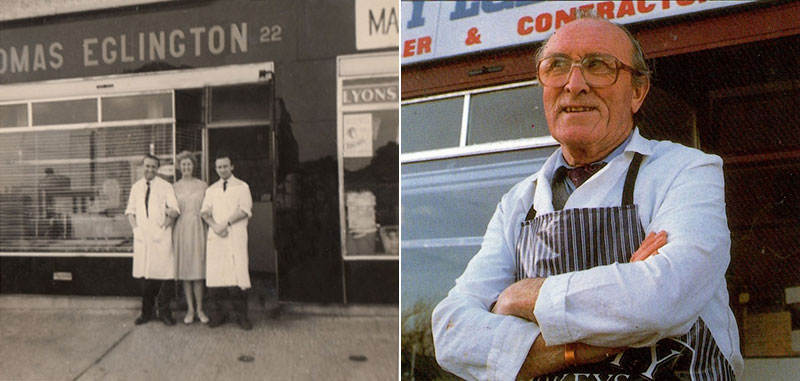
The family butchers in the 1950s; Tommy at his butchers shop in Clontarf in 1991
At the age of 68 Tommy was diagnosed with pancreatic cancer and the prognosis was bleak but the skills of surgeons gave him a new lease of life. He passed away in 2004, aged 81, having lived with vascular dementia in his final three years. Seven years later a display in his honour was unveiled at the FAI head office in Dublin (during his lifetime he was awarded an FAI merit award at half-time in an international match as he had come up just short of the 25 caps required to receive an engraved silver shamrock). His children and grandchildren continue to make regular visits to Goodison Park.
Let’s close with remarks Tommy made in 1955, nine years after moving to Merseyside:
‘No matter where I might be in the years ahead…I shall always have a soft spot in my heart for the Goodison Park club and the hundreds of friendly and hospitable folk I have been fortunate to know.’
Acknowledgment:
My sincere thanks to Tommy’s family for their assistance with this article
Sources:
The Eglington Family
Mick Meagan
The Everton match day programme
Liverpool Echo and Liverpool Daily Post
Irish Toffees Facebook article
Everton Encyclopedia
evertonresults.com
bluecorrespondent.co.uk (Billy Smith)
Photos are from the Eglington family collection and the Everton programme 1st April 1991)

